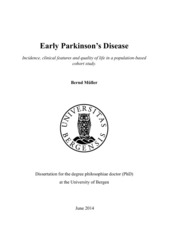| dc.contributor.author | Müller, Bernd | en_US |
| dc.date.accessioned | 2014-06-30T08:48:27Z | |
| dc.date.available | 2014-06-30T08:48:27Z | |
| dc.date.issued | 2014-06-06 | eng |
| dc.identifier.isbn | 978-82-308-2892-2 | en_US |
| dc.identifier.uri | https://hdl.handle.net/1956/8032 | |
| dc.description.abstract | Background: The prevalence of Parkinson’s Disease (PD) in Norway is about 100/100 000 inhabitants. For planning of health care needs and for research purposes, incidence figures are considered the more valuable information, but have in Norway not been available for PD. Earlier incidence studies have shown variable results, likely due to methodological differences. To improve comparability, research criteria for high quality incidence studies of PD have been proposed in 2003. PD is more frequent in men than women, but the underlying causes are not clear. As the difference does not persist throughout all studies and geographic areas, further evidence on the issue is needed, also concerning clinical disparities between genders. Non-motor symptoms have in the last two decades been increasingly recognized as important contributors to the clinical picture of PD, the disease burden and the quality of life of patients. Knowledge on the presence, severity and consequences of nonmotor symptoms, including autonomic and sensory disturbances, is best for mid-stage and advanced PD, but insufficient for the earliest disease stages. There are furthermore discussions as to whether motor or non-motor symptoms are the most important contributors to reduced quality of life in PD. Patients and methods: We followed proposed research criteria and aimed to recruit all cases of incident PD from the Norwegian counties Sogn og Fjordane, Hordaland, Rogaland and Aust-Agder, comprising a base-population of about 1 million inhabitants. Cases with probable PD were invited to further examinations and longitudinal follow-up. Motor symptoms, non-motor symptoms and quality of life were assessed soon after diagnosis in drug-naïve state, and one year and 3 years later. Results and conclusions: Based on 265 cases identified during 22 months and finally diagnosed as incident PD, the crude incidence of PD in Norway was estimated to 13.7/100 000, corresponding to 12.6/100 000 when adapted to a European standard population. This figure is in line with other modern incidence studies in Europe, although there is a persisting, considerable range of the presented incidence numbers (8.4-15.8/100 000). Further homogenization of the methodology for incidence studies may therefore be needed, but could be difficult to achieve. We confirmed an increased risk for PD in men with a male to female ratio of 1.58. Beside a slightly later onset in women clinical differences were lacking in our study. We could thus not provide supporting evidence for neuroprotective mechanisms in women that are effective after PD has become clinically overt. Autonomic and sensory symptoms and signs were very frequent in early, untreated PD. Most frequent were reduced olfaction (59%), urinary problems (47%), increased saliva/drooling (42%), constipation (39%) and sensory complaints (34%), all of which occurred significantly less frequent in controls matched for age and gender. Most patients (58%) were not impaired in their daily activities by any of these symptoms. Although health-related quality of life (HRQoL) was overall reduced in patients compared to controls already at diagnosis, the contribution of autonomic symptoms was small. The main predictors of reduced HRQoL were fatigue and depression, and to a minor degree also sensory complaints. The most important motor symptoms to affect HRQoL were impairment of gait and of the ability to conduct personal needs as eating, dressing, hygiene and to turn in bed. These issues have not been highlighted earlier, and should guide the focus of treating physicians to the here mentioned symptoms in the meeting with patients with very early PD. Our results further indicate that, overall, non-motor symptoms have more impact on HRQoL than motor symptoms, both at the time of diagnosis and three years later. As our patients were initially drug-naïve, this dominance seems to be independent of the often reported better recognition and treatment of motor vs. non-motor symptoms. | en_US |
| dc.language.iso | eng | eng |
| dc.publisher | The University of Bergen | eng |
| dc.relation.haspart | Paper I: Alves G., Müller B., Herlofson K., HogenEsch I., Telstad W., Aarsland D., Tysnes O-B., Larsen J.P., for the Norwegian ParkWest study group (2009): “Incidence of Parkinson’s disease in Norway: the Norwegian ParkWest study”, J Neurol Neurosurg Psychiatry, Vol. 80: 851-857. The article is not available in BORA due to publisher restrictions. The published version is available at: <a href="http://dx.doi.org/10.1136/jnnp.2008.168211" target="blank">http://dx.doi.org/10.1136/jnnp.2008.168211</a> | en_US |
| dc.relation.haspart | Paper II: Müller B., Larsen J.P., Wentzel-Larsen T., Skeie G.O., Tysnes O-B.(2011): ”Autonomic and sensory symptoms and signs in incident, untreated Parkinson’s Disease: Frequent but mild”, Mov Disord, Vol. 26: 65-72. The article is not available in BORA due to publisher restrictions. The published version is available at: <a href="http://dx.doi.org/10.1002/mds.23387" target="blank">http://dx.doi.org/10.1002/mds.23387</a> | en_US |
| dc.relation.haspart | Paper III: Müller B., Assmus J., Larsen J.P., Haugarvoll K., Skeie G.O., Tysnes O-B. (2013): “Autonomic symptoms and dopaminergic treatment in den novo Parkinson’s disease”, Acta Neurol Scand, Vol. 127: 290-294. The article is not available in BORA due to publisher restrictions. The published version is available at: <a href="http://dx.doi.org/10.1111/ane.12010" target="blank">http://dx.doi.org/10.1111/ane.12010</a> | en_US |
| dc.relation.haspart | Paper IV: Müller B., Assmus J., Herlofson K., Larsen J.P., Tysnes O-B. (2013): “Importance of motor vs. non-motor symptoms for health-related quality of life in early Parkinson’s disease”, Parkinsonism Relat Disord, Vol. 19: 1027-1032. The article is not available in BORA due to publisher restrictions. The published version is available at: <a href="http://dx.doi.org/10.1016/j.parkreldis.2013.07.010" target="blank">http://dx.doi.org/10.1016/j.parkreldis.2013.07.010</a> | en_US |
| dc.title | Early Parkinson’s Disease. Incidence, clinical features and quality of life in a population-based cohort study. | en_US |
| dc.type | Doctoral thesis | |
| dc.rights.holder | Copyright the author. All rights reserved | |
| dc.identifier.cristin | 1136146 | |
